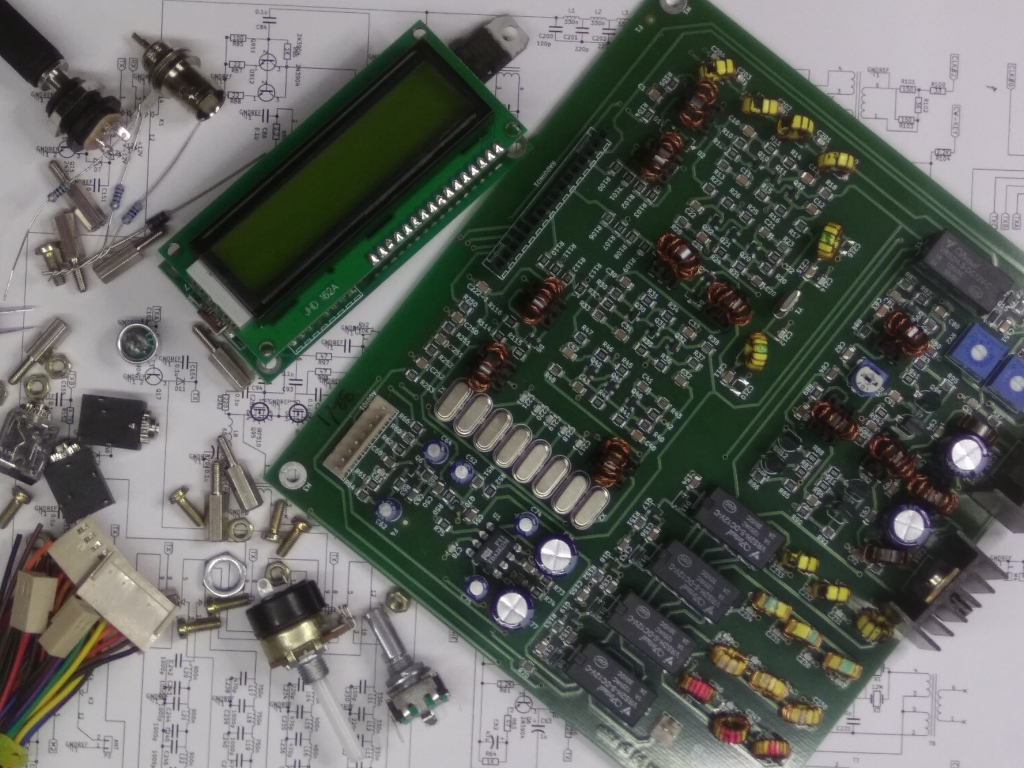The QRP HF General Coverage Transceiver you can build
Circuit Description | Wireup | Tune Up | Help and Support | BITX Hacks
Buy Basic Kit |
Buy the Full kit

![]()
($129 USD)
The µBITX is a general coverage HF SSB/CW transceiver kit with features you NEED for operating ease, convenience and versatility. It works from 3 MHz to 30 MHz, with up to 10 watts on SSB and CW with a very sensitive receiver. It features digital tuning, dual VFOs, RIT, CW Keyer and more. The µBITX is a general coverage HF SSB/CW transceiver kit with features you demand for operating ease, convenience and versatility. It features digital tuning, dual VFOs, RIT, CW Keyer and more.
Need information about the previous version of uBITX?
Click here for V3 | Click here for V4
Operating
It is a joy to operate. Press the tuning control to access all the features. Dual VFOs, RIT, CW speed, sideband selection. etc. are all accessible from a single menu. The transceiver automatically selects the proper sideband for you (you can override it, too).
Technical Specifications
The µBITX is an understandable radio and, hence, can also be a learning experience. The complexity is kept to a minimum so you can always repair and make changes if you so desire.
The µBITX has a carefully thought-out operator interface. The tuning knob features many menu options available with a simple push on the tuning knob. From RIT, to dual VFOs, to the keyer, and many other features are all accessible from the tuning knob by simply pushing on it. There are intelligent defaults everywhere (these are easily overridden). Example : below 10 MHz, it auto-selects LSB and vice versa. To operate CW, you just press the morse key.
Architecture The µBITX uses upconversion to the first IF of 45 MHz. This eliminates the need for a large number of band pass filters, keeping the design simple and virtually image free. The roofing filter at 45 MHz is 15 KHz wide. The signal is then down-converted to 12 MHz where a low ripple SSB filter with 8 crystals is used to provide a sparkling audio.
The transmitter has push-pull PA using two IRF510s for a clean output. The low cost IRF510s are simple and inexpensive to replace should the need ever arise.
Receiver :
- Sensitivity: a 0.2uv signal is clearly audible
- Selectivity: 2.4 KHz, low ripple SSB filter with 8 crystals
- RIT (Receiver Incremental Tuning)
- Continuous coverage from 500 KHz to 30 MHz
- Sideband selection
- Detent-less encoder tuning. Tunes with larger step rates when tuned quickly
Transmitter
- More than 10 watts up to 10 MHz, 7 watts up to 21 MHz, 2 watts on 28 MHz
- CW transmit with the built-in keyer
- Uses IRF510s x 2 as PA and 2N3904 x 4 drivers in push-pull mode for low distortion transmission.
Raduino Features
The Raduino is a small board with an Si5351 clock generator, an Arduino Nano and a 16×2 LCD display. It plugs into the main radio board. The software that controls the radio is written in Arduino’s C langauge.
- Dual VFOs
- RIT
- Manual override of LSB/USB selection
- CW Keyer Speed and tone selection
Can I build it?
Boxing it. You can pack the µBITX in anything from a cookie box to custom-made 19 inch rack. A metal box is highly recommended. We have used it every way including the bareboard on the bench.
Some soldering is required. The kit is easily put-together. You have to mount the board inside an enclosure of your choice, screw in the connectors and solder the wired connectors to the sockets and controls. That’s all. All SMD’s and other components are pre-soldered on the PCB at the factory.
Take a few hours to wire it up. Preparing the enclosure will take most of your time. You will need basic kit-building tools like soldering iron, a VOM. etc. Set aside a few hours to wire it all up and enjoy the experience.
Support is here. Being an Open Source project, support is provided through a very active builders’ community at http://groups.io/g/bitx20. The collective wisdom of thousands of builders is at your disposal. Ashhar Farhan, the designer of µBITX is very active on the group.
What’s included
- A fully test and tuned µBITX HF transceiver board (6″ by 5-1/2″).
- The Raduino board with display with µBITX firmware installed.
- Detent-free tuning encoder with push button for menu access
- 3 audio sockets for the mic, earphones, and keyer
- A high quality BNC Antenna connector
- Power supply connector and jack
- 8 brass standoffs with nuts and bolts for mounting the board(s).
- Reverse protection diode, some resistors for CW keyer.
- Electret mic and a miniature push button for Push-toTalk
- Volume control with on/off switch
You will have to supply your own enclosure, power supply, microphone case, speaker to complete the radio.